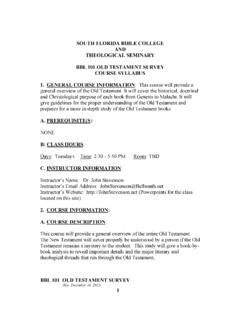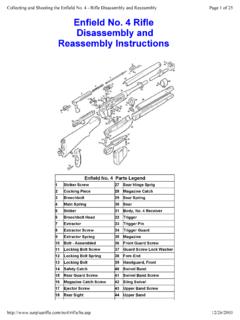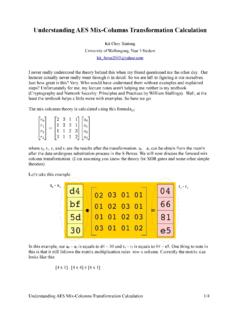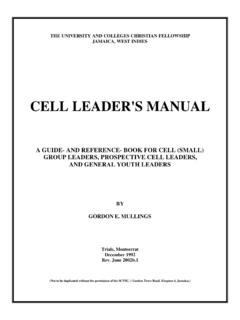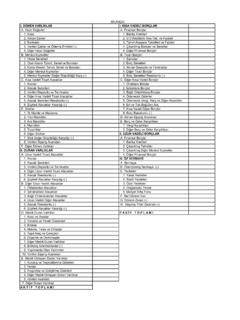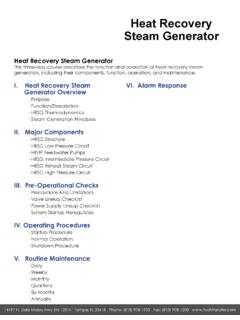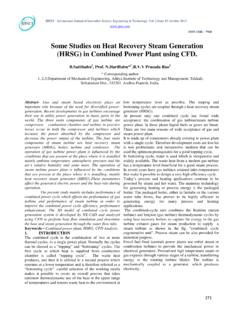Transcription of Heat-Recovery Steam Generators: Understand the …
1 Heat-Recovery Steam generators : Understand the Basics By understanding how gas-turbine Heat-Recovery Steam generators differ from conventional Steam generators , engineers can design and operate HRSG systems that produce Steam efficiently. V. Ganapathy, ABCO Industries Gas turbines with Heat-Recovery - Steam generators (HRSGs) can be found in virtually every chemical process industries (CPI) plant. They can be operated in either the cogeneration mode or the combined-cycle mode (Figure 1). In the cogeneration mode, Steam produced from the HRSG is mainly used for process applications, whereas in the combined-cycle mode, power is generated via a Steam turbine generator.
2 Gas turbines have several advantages as a power source: they can be started up quickly; they come in packaged modules, with power outputs ranging from 3 MW to 100 MW, that can be easily assembled and erected; they have high efficiencies of 25% to 35% (on a lower heating value [LHV] basis); and they require little or no cooling water. Recent developments in-clude large-capacity units of up to 250 MW, with low emission characteristics (less than 10 ppmv NOx), as well as high combustor operating temperatures (in the range of 2,200 F), which results in effi-ciencies higher than 35%; the exhaust gas temperature is also higher, which helps to generate high-pressure/high-temperature superheated Steam , making the Rankine cycle efficient.
3 The HRSG forms a major part of the Steam system. In the combined-cycle mode, the efficiency of the combined gas-turbine-plus-HRSG system can reach 55-60% (LHV basis) with today's advanced machines, while in the cogeneration mode, system efficiency can be as high as 75-85%. The HRSG generates Steam utilizing the energy in the exhaust from the gas turbine. However, some plants also have the capability of producing Steam when the gas turbine is shutdown. This is done using a separate forced-draft fan along with a burner to generate hot gases, which are then used to generate Steam . An isolating damper system (also called a bypass damper) with seal air fans is re-quired in these units to ensure that hot gases do not leak to the fan when the gas turbine is running and that maintenance can be performed on the gas turbine when the fresh air fan is operating.
4 Bypass dampers are also used in some units to ensure that the gas flow to the HRSG can be modulated in order to match Steam generation with Steam demand. However, if fresh air firing is not used, an isolating damper is not required. Recent trends in HRSG design include multiple-pressure units for maximum en-ergy recovery , the use of high-temperature superheaters or reheaters in combined cycle plants, and auxiliary firing for efficient Steam generation. In addition, furnace firing is often employed in small capacity units when the exhaust gas is raised to temperatures of 2,400-3,000 F to maximize Steam generation and thus improve fuel utilization. This article highlights some of the basic facts about gas turbine HRSGs.
5 This information can help plant engineers, consultants, and those planning co-generation projects make important deci-sions about the system and performance related aspects. 32 AUGUST 1996 CHEMICAL ENGINEERING HRSG temperature profiles and Steam generation The starting point in the engineering of a HRSG is the evaluation of its Steam generation capability and gas and Steam temperature profiles. For a conventional fired Steam generator, one can assume a desired Steam flow rate and exit gas temperature and then fire the necessary amount of fuel to meet the Steam demand. A HRSG behaves differently due to the low inlet gas temperature (900-1,050 F in the unfired mode) and the large gas/ Steam ratio.
6 Arbitrarily assuming an exit gas temperature or Steam generation rate can lead to "temperature cross situa-tions" (discussed below). Figure 2 shows the typical gas and Steam temperature profiles in a HRSG consisting of a superheater, evaporator, and economizer operating at a single pressure. Because the gas temperature entering the HRSG is low (900-1,050 F in unfired units), the Steam generation will also be lower than in conventional Steam generators for the same gas flow. (Re CHEMICAL ENGINEERING PROGRESS AUGUST 1996 33 member that conventional Steam gen-erators start out at 3,200 F or so, the adiabatic combustion temperature of the fuels used.)
7 Hence, the economiz-er duty in the HRSG will also be low, leading to a high exit gas tempera-ture. Also (again unlike in a conven-tional Steam generator), the effect of Steam pressure is significant - the higher the Steam pressure, the higher the exit gas temperature from the evaporator and the lower the Steam generation rate, leading to a smaller duty in the economizer and a higher exit gas temperature. This is the rea-son for considering multiple-pressure units, as well as deaeration Steam coils and condensate heaters in HRSGs operating at high pressures. Two variables that directly affect Steam production and the gas and Steam temperature profiles are the pinch point and the approach point (Figure 2) (1).
8 The pinch point is the difference between the gas tempera-ture leaving the evaporator and the temperature of saturated Steam . The approach point is the difference be-tween the temperature of saturated Steam and the temperature of the water entering the evaporator. Selection of these two variables also affects the size of the superheater, the evaporator, and the economizer. Based on the sizes of evaporators that can be built and shipped eco-nomically, the pinch and approach points for unfired HRSGs are usually in the range of 15 F to 30 F. (If one specifically wants to generate less Steam , such as in a multiple-pressure HRSG generating more low-pressure Steam than high-pressure Steam , then a larger pinch and approach may be used.)
9 Pinch and approach points are se-lected for a particular case or exhaust gas condition called the "design case." Unlike in a conventional Steam generator, where the Steam demand drives the design case, in a HRSG Steam production is affected by the conditions of the exhaust gas leaving the gas turbine (such as flow rate, temperature, and gas analysis) and entering the HRSG. Also, these pa-rameters vary with ambient conditions, elevation, gas turbine load, and fuel fired. Hence, the design case could be 60 F ambient condition at 100% load of the gas turbine, or any other accepted gas inlet parameters. Using exhaust gas parameters at this condition, one arrives at the design temperature profile, which forms the basis for sizing the HRSG.
10 The HRSG is then designed, or sized, once the pinch and approach points are selected - that is, the surface areas are determined indirectly. Once selected, the pinch and approach points will vary if gas flow and exhaust gas temperature vary. These cases are called "off-design" cases. For example, at different ambient conditions and gas turbine loads, one can have different exhaust gas parameters, or one may have to burn auxiliary fuel to generate a desired quantity of Steam . There is only one design case, but several off-design cases. Prudent engineering calls for the pinch and approach points to be es-tablished in the unfired mode (2, 3) rather than in the fired mode, for sev-eral reasons: 1.


